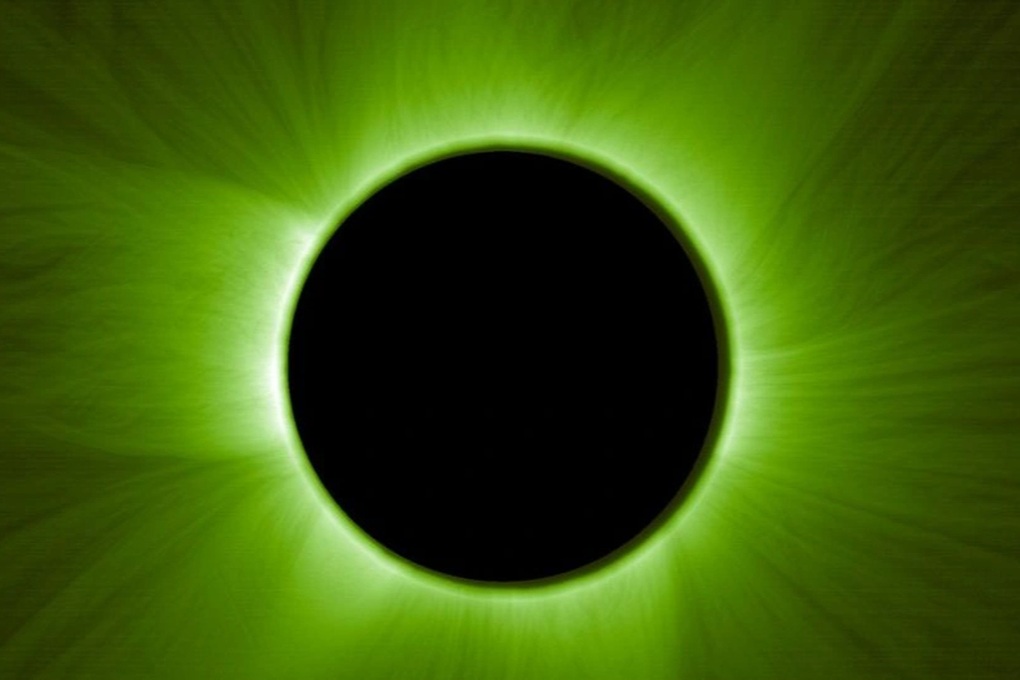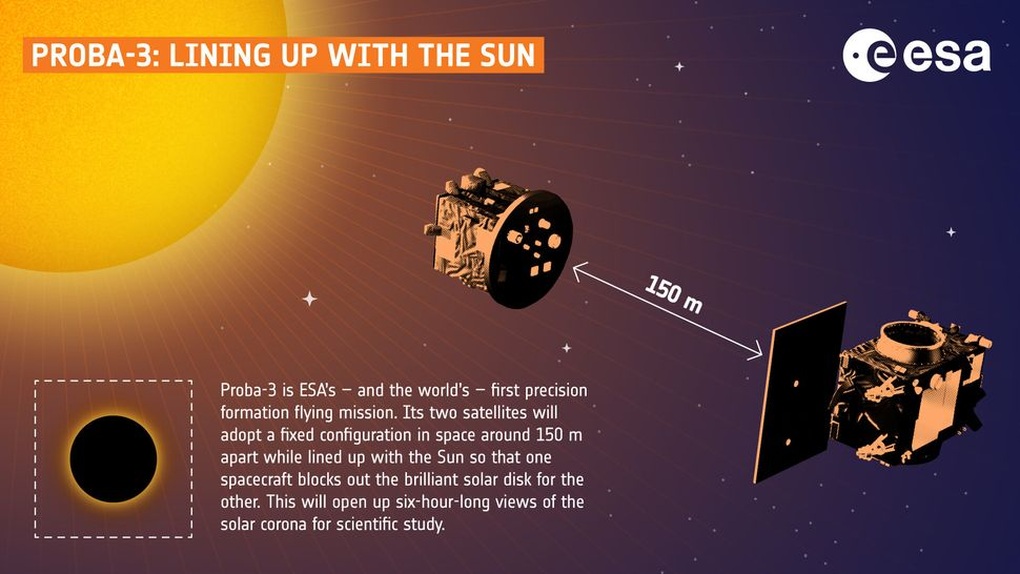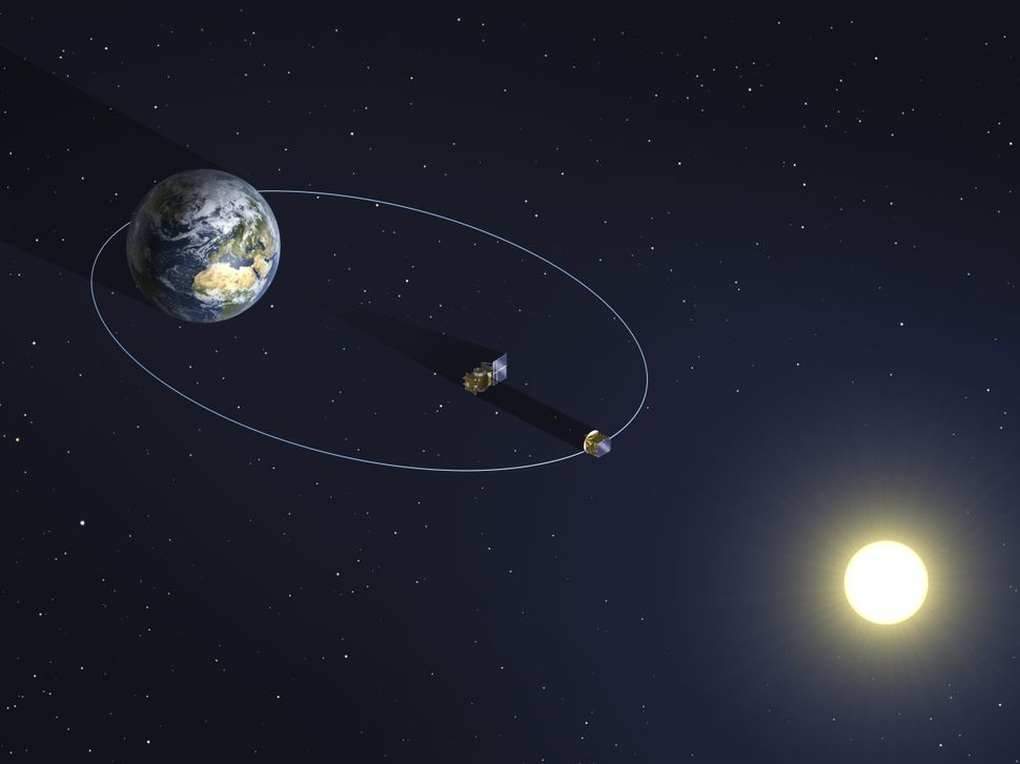Mission to create the first "artificial eclipse" in history

The Sun's inner corona appears green in visible light, as captured on May 23 by the ASPIICS telescope on board Proba-3 (Image: ESA).
It was created by two satellites operating in space as part of the Proba-3 mission.
Proba-3 allows humans to create an artificial solar eclipse every 19.6 hours, instead of waiting 360 years for a natural total solar eclipse at the same location.
This is the first time humans have deliberately created an event similar to a total solar eclipse, with the aim of studying the corona, which is also the outermost and most mysterious layer of the Sun's atmosphere.
The Proba-3 mission, launched by ESA from the Satish Dhawan Space Centre (India) on December 5, consists of two satellites. One satellite acts as an "artificial moon" tasked with occulting the Sun, and the other satellite carries the ASPIICS telescope, pointing directly at the occulted area for observation.
On May 23, during their first flight test, the two satellites aligned with millimeter accuracy at a distance of 150 meters, creating unprecedentedly clear images of the Sun's corona.

How the Proba-3 mission created an "artificial eclipse" (Photo: ESA).
According to Space , Proba-3 is the world's first precision formation mission, with an elliptical orbit with a perigee of 600 km and an apogee of 60,000 km. Formation flights are only performed when the two satellites are at apogee (where gravity, magnetic field and atmospheric drag are at a minimum), helping to save maximum fuel.
There, the occulting satellite, which was 1.4 metres in diameter, cast a shadow of just 8cm over the other satellite’s observation point, a feat of precision that ESA called “extraordinary”.
Another notable point is that the "artificial eclipse" images were made up of three frames with different exposure times, which were then processed and combined by scientists at the Royal Observatory of Belgium to recreate the whole scene.
A new era for space weather observation and forecasting
The corona is the outermost atmosphere of the Sun, with temperatures reaching more than 2 million degrees Fahrenheit – 200 times hotter than the surface of the Sun, but the reason why this layer has such a high temperature remains a mystery.
It is also home to solar wind and coronal mass ejections (CMEs) – events that can have serious impacts on communications systems, satellites and power grids on Earth.
Studying the corona under normal conditions is inherently extremely difficult, because the Sun's disk is about 1 million times brighter than the atmosphere.
To do this, people use devices called coronagraphs to block out light from the Sun to observe the corona. However, when placed on the ground, they are strongly affected by the atmosphere, causing significant interference.
Therefore, a coronagraph system operating in space like Proba-3 will bring a distinct advantage.

The Proba-3 satellite pair will have an elliptical orbit, flying around the Earth (Photo: ESA).
According to Andrei Zhukov, principal investigator of the ASPIICS project, the images sent back by Proba-3 not only show the detailed structure of the corona, but also record cold bulges. This is a phenomenon of cold plasma with a temperature of about 10,000 degrees Celsius standing out against the hot plasma of millions of degrees.
These are also features that are only observable during total solar eclipses, and can now be studied more regularly thanks to Proba-3.
In fact, the idea of creating an artificial eclipse was first realized in 1975 in the Apollo-Soyuz Test Project between the US and the Soviet Union. However, the technological conditions at that time were limited and the images obtained were very modest.
With Proba-3, for the first time humans will be able to create a periodic artificial eclipse, estimated to occur every 19.6 orbital hours, instead of having to wait an average of more than 360 years to witness a total eclipse at a specific location on Earth.
Source: https://dantri.com.vn/khoa-hoc/hinh-anh-dau-tien-ve-nhat-thuc-toan-phan-nhan-tao-20250617180230231.htm



![[Photo] The 1st Congress of Phu Tho Provincial Party Committee, term 2025-2030](https://vphoto.vietnam.vn/thumb/1200x675/vietnam/resource/IMAGE/2025/9/30/1507da06216649bba8a1ce6251816820)
![[Photo] General Secretary To Lam, Secretary of the Central Military Commission attends the 12th Party Congress of the Army](https://vphoto.vietnam.vn/thumb/1200x675/vietnam/resource/IMAGE/2025/9/30/9b63aaa37ddb472ead84e3870a8ae825)
![[Photo] President Luong Cuong receives President of the Cuban National Assembly Esteban Lazo Hernandez](https://vphoto.vietnam.vn/thumb/1200x675/vietnam/resource/IMAGE/2025/9/30/4d38932911c24f6ea1936252bd5427fa)
![[Photo] Panorama of the cable-stayed bridge, the final bottleneck of the Ben Luc-Long Thanh expressway](https://vphoto.vietnam.vn/thumb/1200x675/vietnam/resource/IMAGE/2025/9/30/391fdf21025541d6b2f092e49a17243f)
![[Photo] Solemn opening of the 12th Military Party Congress for the 2025-2030 term](https://vphoto.vietnam.vn/thumb/1200x675/vietnam/resource/IMAGE/2025/9/30/2cd383b3130d41a1a4b5ace0d5eb989d)






























































































Comment (0)